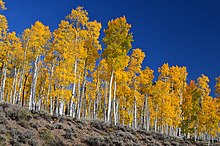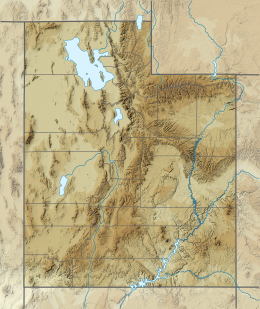
Back باندو (شجرة) Arabic Pando Czech Pando (Baum) German Pando (árbol) Spanish Pando (arbre) French Պանդո (ծառ) Armenian Pando (pohon) ID Pando (albero) Italian Pando LMO Pando Lithuanian
This article's lead section may be too long. (January 2025) |
| Pando | |
|---|---|
 Image of the approximate land mass of Pando shaded green | |
| Map | |
Location in Utah | |
| Geography | |
| Location | Sevier County, Utah, United States |
| Coordinates | 38°31′30″N 111°45′00″W / 38.52500°N 111.75000°W |
| Elevation | 2,700 m (8,900 ft) |
| Area | 43.6 ha (108 acres) |
| Administration | |
| Established | +14000 BP |
| Ecology | |
| Dominant tree species | Populus tremuloides |

Pando (from Latin pando 'I spread')[1] is the world's largest tree, a quaking aspen (Populus tremuloides) located in Sevier County, Utah, United States, in the Fishlake National Forest. A male clonal organism, Pando has an estimated 47,000 stems (ramets) that appear to be individual trees but are not, because those stems are connected by a root system that spans 42.8 ha (106 acres). Pando is the largest tree by weight and landmass and the largest known aspen clone. Pando was identified as a single living organism because each of its stems possesses identical genetic markers.[2] The massive interconnected root system coordinates energy production, defense and regeneration across the tree's landmass.[3] Pando spans 1.08 km × 0.72 km (0.67 mi × 0.45 mi) at its widest expanse along of the southwestern edge of the Fishlake Basin and lies 0.69 km (0.43 mi) to the west of Fish Lake, the largest natural mountain freshwater lake in Utah.[4] Pando's landmass spreads from 2,700 m (8,900 ft) above sea level to approximately 2,773 m (9,098 ft) above sea level along the western side of a steep basin wall.[5] Pando is estimated to weigh collectively 6,000 tonnes (6,000,000 kg),[6] or 13.2 million pounds, making it the heaviest known organism.[7][8] The Pando Tree's 43-hectare (106-acre) expanse also makes Pando the largest tree of any kind, by way of landmass.
Systems of classification used to define large trees vary considerably, leading to some confusion about Pando's status. Within the United States, the Official Register of Champion Trees defines the largest trees in a species-specific way; in this case, Pando is the largest aspen tree (Populus tremuloides). In forestry, the largest trees are measured by the greatest volume of a single stem, regardless of species. In that case, the General Sherman Tree is the largest unitary (single-stem) tree. While many emphasize that Pando is the largest clonal organism, other large trees, including Redwoods can also reproduce via cloning. Pando being the heaviest tree and the largest tree by landmass, while also being the largest aspen clone leaves the Pando Tree in a class of its own.
Since the early 2000s, little information has been adequately corroborated about Pando's origins and how its genetic integrity has been sustained over a long period of time, conservatively between 9,000 and 16,000 years old-by the latest (2024) estimate.[9] Researchers have argued that Pando's future is uncertain due to a combination of factors including drought, cattle grazing, and fire suppression.[10][11] In terms of drought, Pando's long lived nature suggests it has survived droughts that have driven out human societies for centuries at a time. In terms of grazing, a majority of Pando's land mass is fenced for permanent protection and management as a unique tree. In terms of cattle grazing, it is only permitted on a volume basis for 10 days a year in October, weather permitting in a small edge of Pando's expanse. Additionally, in 2023, local grazers group 7-Mile Grazers signed off on a plan[12] that would bring remaining portions of Pando into protective care under the "Pando Protection Plan", which would bring nearly 34 hectares (84 acres) of the tree into protective care. In terms of fire suppression, research indicates[13] Pando has survived fires that would have likely leveled the tree many times, after which Pando regenerated itself from the root system. The same research also indicates large-scale fire events are infrequent, which may be owed to the fact that aspen are water-heavy trees and thus, naturally fire resistant, earning them the name "asbestos forest" by Canadian Forest Ecologist Lori Daniels.[14] There is broad consensus that wildlife controls and protection from deer and elk who feed on the new growth faster than it can reach maturity are critical to Pando's future and care. Protection systems coupled with ongoing monitoring and restoration efforts have been shown to be the most effective, dating back to the first projects to protect and care for the tree in the late 1980s and early 1990s, with new projects under way.[15]
Friends of Pando[16] and the Fishlake National Forest partners to study and protect the Pando Tree working alongside Utah Division of Wildlife Resources.[17] Notable organizations that also study and advocate to protect Pando's care include Western Aspen Alliance[18] and Grand Canyon Trust.[19]
- ^ Grant, Michael C. (October 1993). "The Trembling Giant". Discover. Vol. 14, no. 10. Chicago. pp. 82–89. Retrieved May 8, 2008.
- ^ DeWoody, Jennifer; Rowe, Carol A.; Hipkins, Valerie D.; Mock, Karen E. (2008). ""Pando" Lives: Molecular Genetic Evidence of a Giant Aspen Clone in Central Utah". Western North American Naturalist. 68 (4): 493–497. Bibcode:2008WNAN...68..493D. doi:10.3398/1527-0904-68.4.493. S2CID 59135424.
- ^ "Frequently asked questions about the World's Largest Tree". Friends of Pando. Retrieved October 31, 2023.
- ^ "Pando". USDA Forest Service. Retrieved August 24, 2013.
- ^ Google Earth
- ^ OECD (2000). Consensus Document on the Biology of Populus L. (Poplars) (PDF). Series on Harmonization of Regulatory Oversight in Biotechnology. Vol. 16. Paris: Organisation for Economic Co-operation and Development. Retrieved November 17, 2018.
- ^ Mitton, Jeffry B.; Grant, Michael C. (1996). "Genetic Variation and the Natural History of Quaking Aspen". BioScience. 46 (1): 25–31. doi:10.2307/1312652. JSTOR 1312652.
- ^ Mihai, Andrei (February 9, 2015). "The Heaviest Living Organism in the World". ZME Science. Retrieved February 12, 2015.
- ^ Pineau, Rozenn M.; Mock, Karen E.; Morris, Jesse; Kraklow, Vachel; Brunelle, Andrea; Pageot, Aurore; Ratcliff, William C.; Gompert, Zachariah (2024). "Mosaic of Somatic Mutations in Earth's Oldest Living Organism, Pando" (PDF). doi:10.1101/2024.10.19.619233. PMC 11526904. PMID 39484516.
- ^ Rogers, Paul C.; Gale, Jody A. (2017). "Restoration of the iconic Pando aspen clone: Emerging evidence of recovery". Ecosphere. 8 (1): 1–15. Bibcode:2017Ecosp...8E1661R. doi:10.1002/ecs2.1661.
- ^ Rogers, Paul C.; McAvoy, Darren J. (October 17, 2018). "Mule deer impede Pando's recovery: Implications for aspen resilience from a single-genotype forest". PLOS ONE. 13 (10): e0203619. Bibcode:2018PLoSO..1303619R. doi:10.1371/journal.pone.0203619. ISSN 1932-6203. PMC 6192553. PMID 30332420.
- ^ "Pando: Protecting Utah's Natural Wonder While Improving Highway Safety" (PDF). utah.gov. 2024.
- ^ Novák, Jan; Kusbach, Antonín; Šebesta, Jan; Rogers, Paul C. (October 1, 2022). "Soil macrocharcoals reveal millennial-scale stability at the Pando aspen clonal colony, Utah, USA". Forest Ecology and Management. 521: 120436. Bibcode:2022ForEM.52120436N. doi:10.1016/j.foreco.2022.120436. ISSN 0378-1127.
- ^ Lindsay, Bethany (November 17, 2018). "'It blows my mind': How B.C. destroys a key natural wildfire defence every year". Canadian Broadcast Corportion. Retrieved April 12, 2024.
- ^ Walton, Richard Elton (September 28, 2024). "Earth's Largest Organism Is Slowly Being Eaten, Scientist Says". The Conversation. Retrieved September 28, 2024 – via ScienceAlert.
- ^ "Friends of Pando". Friends of Pando. Retrieved November 2, 2023.
- ^ Harkins, Paighten (August 14, 2023). "Once given a death sentence, Utah's Pando aspen grove has 'come a long way'". The Salt Lake Tribune. Retrieved December 20, 2023.
- ^ University, Utah State. "Western Aspen Alliance". qcnr.usu.edu. Retrieved November 2, 2023.
- ^ "Pando Clone Recovery". Grand Canyon Trust. March 5, 2020. Retrieved November 2, 2023.

